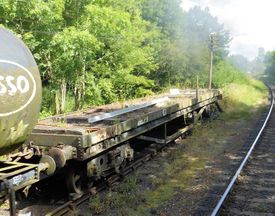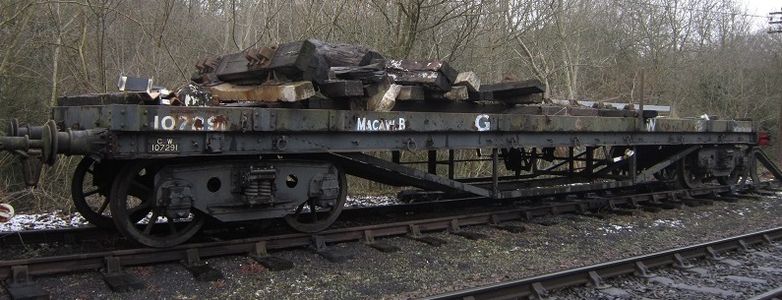GWR 107291 Macaw B Bogie Bolster
| GWR 107291 Macaw B Bogie Bolster | |
|---|---|
 GWR 107291 Macaw B Bogie Bolster | |
| Built By | GWR Swindon |
| Number | 107291 |
| Other Numbers | W107291 |
| History | |
| Built | 1935 |
| Diagram | J21 |
| Lot | 1169 |
| Type | Bogie bolster |
| Capacity | 30 tons |
| Telegraphic code | MACAW B |
| TOPS code | BCO |
| 1971 | Arrived on SVR |
| 1985 | GWR 150 main line appearance |
Contents
Design and service
Within the GWR Diagram Book, Diagram J covered rail and timber bolster wagons, principally the MACAW and the larger GANE. The MACAW (8 ton) and MACAW A (14 ton) were smaller 4-wheeled wagons. The MACAW B was a successful design, first introduced in 1904[note 1] and continuing to be built over the next fifty years with minor design changes. It was fitted with 5ft 6in plateframe bogies and had a 30 ton capacity. At 45 foot length in length over the headstocks, it was the same length as the as the original 40 ton GANE. A modified version of the MACAW B was built for military use in World War 1 (Diagram J17) with a new non-military version introduced at the same time (Diagram J21), the main difference over previous versions being large-headed self-contained buffing and drawgear.[1]
107291 was built at Swindon in 1935 to Diagram J21, Lot 1169.[2] It saw service with the GWR and BR(W) and later with the Round Oak Steel Works at Brierley Hill[3].
Preservation
107291 arrived from Round Oak on 22 March 1971, having been acquired for preservation by the Great Western (SVR) Association.[note 2] It was quickly restored for use in service as a P.W. vehicle, that use being interrupted by a brief spell as a mock 'Pullman' carriage for filming of The Seven-Per-Cent Solution in 1975.[3]
In 1985, 107291 appeared on the main line when it was used in the GW 150 demonstration freight train which ran to Newport behind GWR freight loco 2857.[4]
The following year 107291 was repainted over Easter, the finish resulting in a darker shade of grey. Some minor repairs were also carried out and seven rotten timbers were replaced as a stop-gap measure.[5] It returned to Bewdley in August for a complete floor replacement, for which the timber cost over £1,000. Steve Peplow's 'Wagon Repair Notes' recorded that he had "...the dubious honour of being the only person to fall through the old floor during its removal, fortunately without serious injury. This only serves to prove the importance of renewing floor timbers on these vehicles as soon as is practically possible, before someone is hurt." A missing brake gear safety strap was also replaced.[6]
107291 continued in regular use as a transporter of rails, sleepers and point-work on the railway.[3] However in recent years such duties have generally been taken over by more modern stock, with 107291 mostly spending time in sidings along the line. The main article picture shows the wagon in a siding at Highley in August 2016. As of 2021[update] 107291 is one of several wagons stored out of use in the 'Tenbury siding' at Bewdley.
Although the Great Western (SVR) Association owns GWR Mogul 7325 and around 20 carriages, 107291 is their only wagon.
'Mainline Railways' produced an OO Gauge model of 107291.[7]
See also
Notes
References
- ↑ Atkins, Beard & Tourret (2013) pp. 190-198.
- ↑ Atkins, Beard & Tourret (2013) p. 21.
- ↑ 3.0 3.1 3.2 SVR Stock Book 9th Edition
- ↑ SVR News 78
- ↑ SVR News 80
- ↑ SVR News 82
- ↑ Hampshire Models
